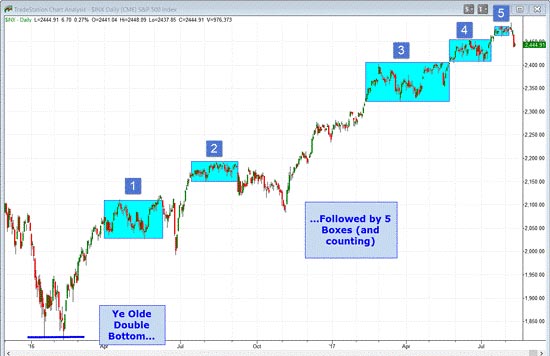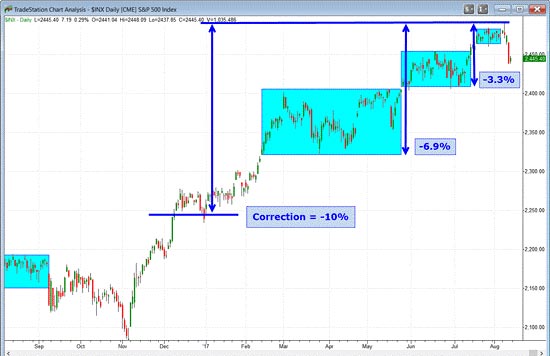Friday was another down day in a relatively volatile week where not every dip was what it seemed.
We've only had 13 other trading days with a drop of 1% or bigger since February 2016.
But for us, that number isn't much of a surprise.
You already know that we've been in a grinding bull market since that early 2016 double bottom, excluding the minor pullbacks following the June 2016 Brexit vote and the October 2016 pre-election jitters.
Other than that, the story has gone like this: push up, enter a sideways box, push up, enter another sideways box...
Lather, rinse, and repeat...
The chart picture is striking, and I'm going to show it to you along with a chart that shows when we might have to start moving to a defensive posture.
We've Moved Through Five Boxes So Far
 We already know that the boxes containing sideways - or "directionless" - price movements can be a challenging time for traders looking to catch a directional trade rather than playing the handful of stocks showing "extreme" behavior at an otherwise quiet time.
We already know that the boxes containing sideways - or "directionless" - price movements can be a challenging time for traders looking to catch a directional trade rather than playing the handful of stocks showing "extreme" behavior at an otherwise quiet time.
Quiet is relative, though. Thanks to our Hooke Pattern system, my Stealth Profits Trader readers have pulled in 53 triple-digit winners in this timeframe, and if you're playing the extremes, you've probably done well, too.
That's why I mentioned the stinkin' boxes in the first place.
Today, we'll use the boxes for something other than to shout about a "Do Nothing Market" with colorful language attached.
Because the big question is this: Does this renewed volatility, and all the geopolitical worry surrounding the bombastic leader of North Korea, mean we should do anything different with our portfolio or trading?
Strangely (and wonderfully), the answers lie within those infamous boxes.
Let me explain...
Here's How We Find Market Support and Resistance
[mmpazkzone name="in-story" network="9794" site="307044" id="137008" type="4"]
Now, I've used our boxes to show price channels for congested trading because they beautifully illustrate just now narrow the "breadth" of the market has become.
But these boxes show something even more useful to traders: important support and resistance areas.
That function will tell us whether we should react to North Korean news - or any other news, for that matter.
Small drops in the market are expected - even in a grinding bull market.
I'll even go so far as to say they are necessary...
The trick is understanding how far down is too far down. And that's where our boxes can help.
Let's go to the chart to see what I mean...
We'll look at a shorter term, which is to say a "bigger" version of the previous chart:

In the chart, we can see that the down day on Thursday took us back inside our May-July box.
The bottom of that box will provide significant support... but it is only 3.8% below the all-time high made on Tuesday.
What would it mean for our portfolio if the market traded down to the bottom of that box?
Absolutely nothing. A 3.3% pullback is very routine.
Now... how about a drop to test the support created by the bottom of the bigger February-May box?
There would be weeping and gnashing of teeth among those who have grown accustomed to the rhythms of the grinding bull market. But, once again, it would have almost no influence on our market outlook.
But... a close or two below the bottom of the February-May box? That would get my attention.
Because that move could set us up to go down enough for a full-fledged, classic market correction.
In other words, below the bottom of this box, things get interesting.
In technical analysis terms, a "correction" is defined as a 10% pullback. I've marked that level on the chart above for reference. The only thing meaningful about a correction would be that it would clear the way to test the pre-election close.
Here's the bottom line for me: As long as the S&P 500 stays above the 2400-2410 zone, there is absolutely no change in the "tone" of the market.
Below that level, it'll make good sense to take a defensive posture and think hard about changing our trading bias to bearish.
Until then, we'll keep charging ahead on schedule, trading those extremes, and pulling in more double- and triple-digit winners along the way.
Follow D.R. on Facebook and Twitter.
About the Author
D.R. Barton, Jr., Technical Trading Specialist for Money Map Press, is a world-renowned authority on technical trading with 25 years of experience. He spent the first part of his career as a chemical engineer with DuPont. During this time, he researched and developed the trading secrets that led to his first successful research service. Thanks to the wealth he was able to create for himself and his followers, D.R. retired early to pursue his passion for investing and showing fellow investors how to build toward financial freedom.



